Related Posts
Read more news on Estuary Resilience’s work in the field.
By Hannah Stoakes
For the past five years, The Nature Trust of British Columbia and the West Coast Conservation Land Management Program (WCCLMP) has been working alongside First Nations partners, environmental NGOs, provincial and federal governments, and academic entities on the Estuary Resilience project. In early February, our partners gathered in person for a Celebration Symposium hosted by The Nature Trust and Snuneymuxw First Nation. With presentations, storytelling, and conversations, our partners reflected on the work we’ve done together to assess estuaries’ resilience in British Columbia, and enhance the long-term sustainability and health of wild salmon.
The Estuary Resilience Celebration Symposium kicked off with a welcome reception the evening before the main event, welcoming guests who arrived from up and down the coast, some from as far as Haida Gwaii and Bella Coola. Sonja, Curtis and Hannah from the WCCLMP greeted guests as they arrived and directed them to the refreshments and snacks. This reception, sponsored by the Pacific Salmon Foundation (PSF) and hosted at the Vancouver Island Convention Center (VICC), was a great way for guests to connect with each other and with Nature Trust staff. After short welcome speeches from Jim Shinkewski, Director of Grants and Community Programs at PSF and Tom Reid, West Coast Conservation Land Manager at the Nature Trust of BC, symposium attendees had a chance to mingle for a few hours.
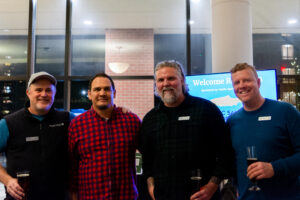
Tom Reid (NTBC), John White (Snuneymuxw First Nation), Jason Emery (NTBC), and Steve Henstra (NTBC).
Bright and early on the morning of February 8th, WCCLMP staff headed down to VICC to assist The Nature Trust set up the registration desks where we checked in guests and distributed swag bags, name tags, highlight reports, and program booklets with an agenda for the day. A booth is set up with Ay Lelum clothing and accessories featuring beautiful Traditional Coast Salish Art for guests to browse; a few of us cannot resist and purchase some of their colourful scrunchies.
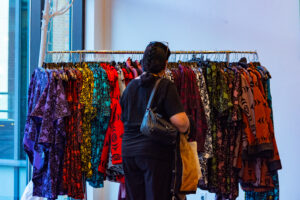
A symposium attendee browsing Ay Lelum clothing.
As the attendees start to trickle in, our team registers them, distributes symposium material, and sends them down the hall for a quick breakfast and hot drinks before the presentations start. It’s great to see so many familiar faces and new ones as well. Guests mingle excitedly waiting for the presentations to begin.
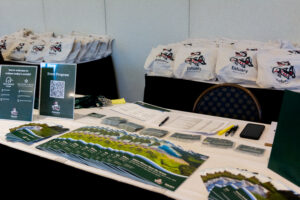
Registration desks with swag bags, highlight reports, program booklets and name tags.
Once everyone has settled into the auditorium, we received a warm welcome to Snuneymuxw First Nation’s Traditional Territory from Snuneymuxw Elder Xulsimalt Gary Manson, as well as a territory welcome in the form of a traditional song. This powerful welcome sets the tone for the rest of the day.
Following this greeting, we are introduced to Mo Dawson, a graphic recorder who visually represented the symposium throughout the day with illustrations and key points. Throughout the day’s presentations, attendees sneak glances at the beautiful graphic recording taking shape at the ack of the room. The morning sessions consisted of informative presentations on the Marsh Resilience to Sea-Level Rise (MARS) metrics and results, fish sampling and water quality results, First Nations storytelling, and videos made by Hakai highlighting the beauty of estuaries and the wildlife that live there. Snuneymuxw Elder C’tasi:a Geraldine Manson reminded us of why we are doing this work, telling stories about the abundance of the Nanaimo River Estuary pre–colonization, and the importance of Snuneymuxw First Nation stewarding these lands.
After a lunch break, the afternoon began with an informative presentation on carbon sequestration, followed by two powerful talks on Indigenous food systems. These presentations challenged us to think differently about our role in ecosystems management, and many of us who heard Dr. Jennifer Grenz and Jared Qwustenuxun Williams speak walked away with a new perspective on how we view conservation and restoration.
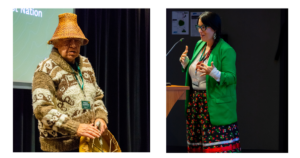
Left: Snuneymuxw Elder Xulsimalt Gary Manson ; Right: Dr. Jennifer Grenz
Following a short break, the rest of the afternoon consisted of short presentations from our project partners, highlighting the many people and organizations involved in making this project happen and the important work that they do.
Additionally, a representative from the United Nations made the announcement that the project was recognized and endorsed by UNESCO as part of the Decade of Ocean Science for Sustainable Development. It is an honour to receive international recognition for this project, and a reflection of all our partners’ commitment to collaborate in a meaningful way to ensure these ecosystems are resilient into the future.
Graphic recorder Mo Dawson takes us through his illustration, highlighting the key points and takeaways of the day. A final Hakai video highlights interviews from WCCLMP staff and First Nation partners speaking about the project and why it has been important to them.
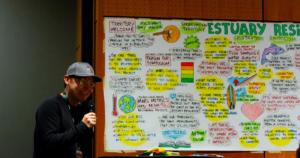
Mo Dawson presenting his graphic recording.
As the symposium came to a close, Snuneymuxw Elder Shxuysulwut Lolly Good ended the day with a closing song and blessing. She engaged all the guests, getting us all up on our feet for a much-needed energizing song after a long day of sitting, listening and reflecting. We all get a tambourine or shaker and follow her lead as she closes the day with a fun, positive song.
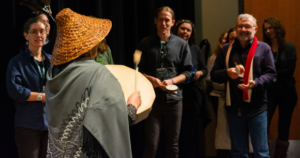
Snuneymuxw Elder Shxuysulwut Lolly Good leading the group in a closing song.
With presentations, storytelling, conversations, and music, today we were able to reflect on the collaborative work we have done together in these 15 estuaries. The Estuary Resilience Project is built on its partnerships with First Nations, environmental NGOs, provincial and federal governments, and academic groups, and would not be possible without them. It is wonderful to see so many people come together today towards a common goal: to heal the land and work together to ensure these important environments thrive into the future.
Read more news on Estuary Resilience’s work in the field.